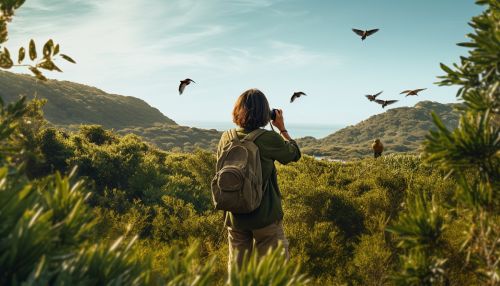Birdwatching
Introduction
Birdwatching, or birding, is the observation and study of birds in their natural habitats. This hobby, which can be pursued by individuals of all ages, combines elements of natural history, ecology, and even photography. Birdwatchers, or birders, use a variety of tools and techniques to locate and identify different bird species, contributing to our understanding of bird behavior, distribution, and conservation needs.
History
The practice of observing birds dates back to prehistoric times, when early humans would have watched birds for signs of changing seasons or impending danger. However, the modern hobby of birdwatching is generally considered to have begun in the late 19th century in Britain and the United States, where it was associated with the growing interest in natural history Read more.


Equipment
Birdwatchers use a range of equipment to enhance their ability to observe and identify birds. The most common tools include binoculars, spotting scopes, field guides, and cameras. Some birders also use audio equipment to record and identify bird calls and songs Learn more.
Binoculars
Binoculars are the most essential tool for birdwatching. They allow birders to view birds up close while maintaining a safe and respectful distance. Binoculars for birding typically have a magnification of 7x to 10x, which provides a good balance between magnification, field of view, and stability.
Spotting Scopes
Spotting scopes are used for observing birds at greater distances, such as across bodies of water or in open country. These devices provide higher magnification than binoculars, but they are also heavier and require a tripod for stability.
Field Guides
Field guides are books or apps that provide information about different bird species, including their physical characteristics, behaviors, habitats, and ranges. These guides often include illustrations or photographs to help birders identify birds in the field.
Cameras
Many birdwatchers enjoy photographing the birds they observe, both for personal enjoyment and to aid in identification. Bird photography requires a camera with a good zoom lens, and may also involve the use of hides or blinds to get close to the birds without disturbing them.
Techniques
Birdwatching techniques can vary widely depending on the location, the time of year, and the specific goals of the birder. However, some common techniques include field observation, bird feeding, and bird ringing.
Field Observation
Field observation is the most common birdwatching technique. This involves simply going out into a natural area and observing the birds that are present. Birders may choose to sit quietly in one spot, or they may walk slowly through the area, stopping frequently to watch and listen.
Bird Feeding
Bird feeding involves providing food for birds in order to attract them to a specific location for observation. This can be done in a backyard setting with bird feeders, or in a more natural setting with appropriate native foods.
Bird Ringing
Bird ringing, or banding, is a technique used by researchers to study individual birds over time. This involves capturing birds, fitting them with a small, uniquely numbered metal or plastic ring, and then releasing them. Birders who observe a ringed bird can report the sighting, contributing to scientific research.
Birdwatching and Conservation
Birdwatching plays an important role in bird conservation. By observing birds in their natural habitats, birders can contribute to our understanding of bird populations and their needs. Many birdwatchers participate in citizen science projects, such as bird counts or nest monitoring programs, which provide valuable data for conservation efforts.
